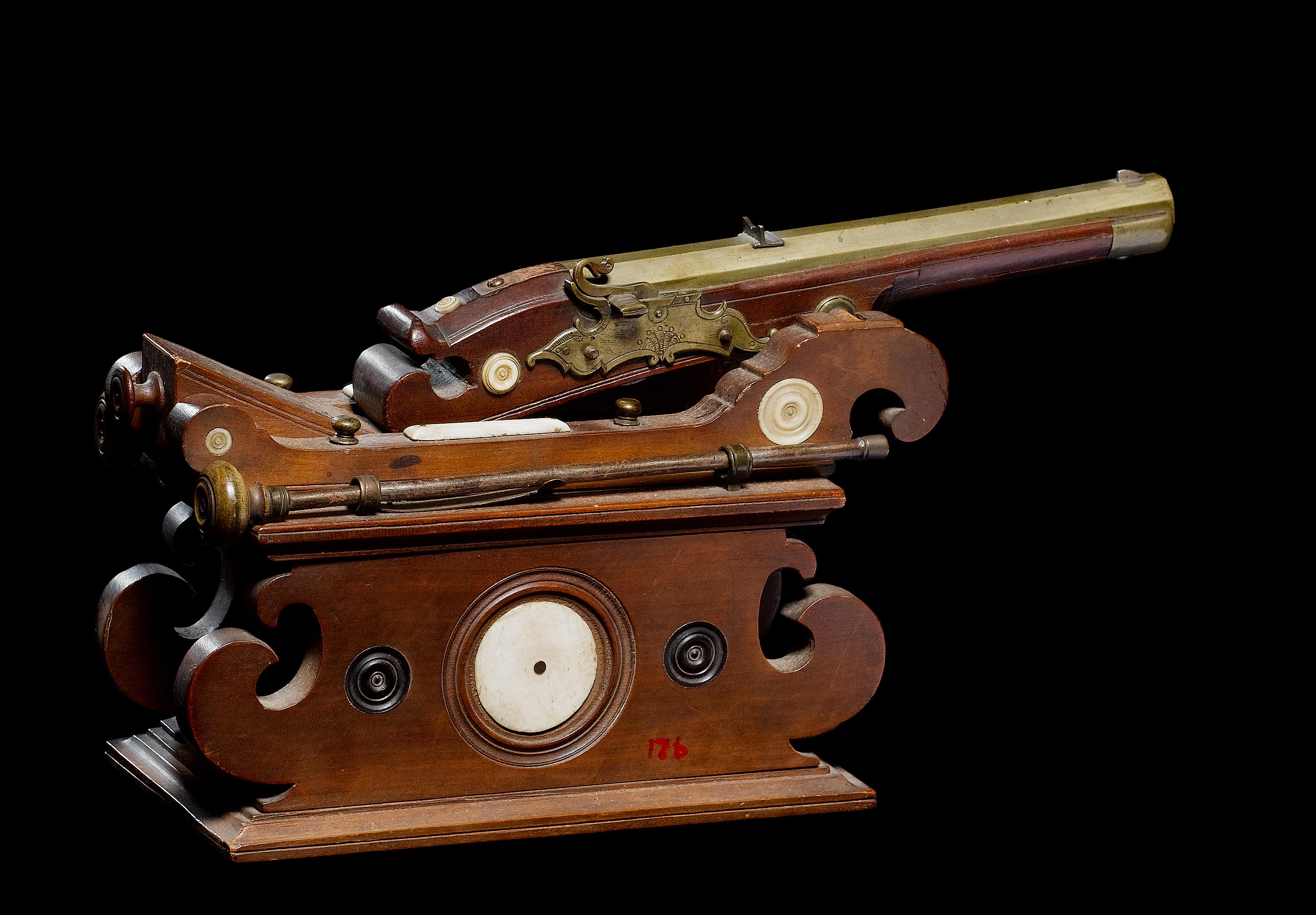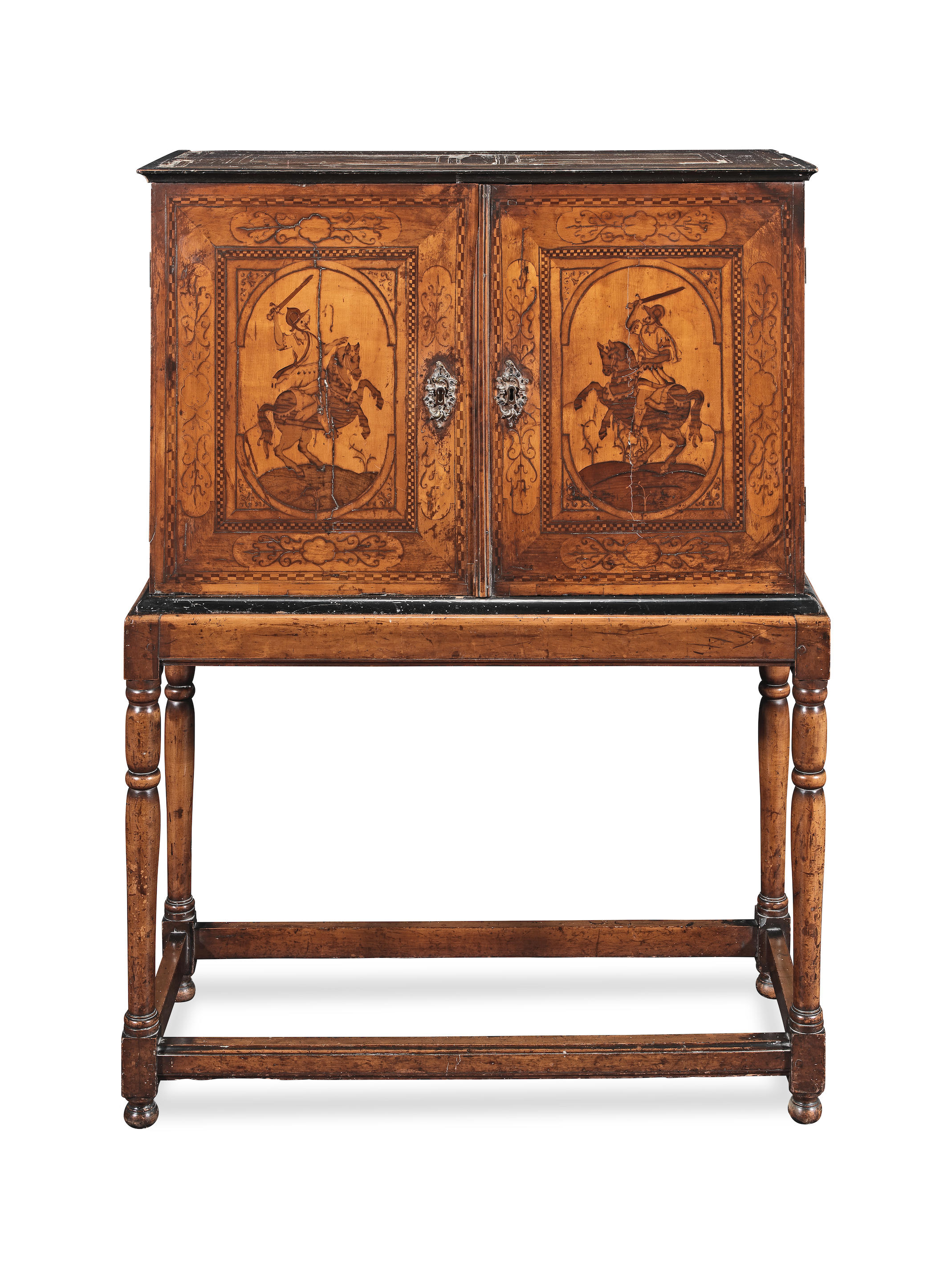Two similar German fruitwood cased floating gnomon horizontal compass sundials One signed for Johann Paul Stockert, both circa 1800 Each with circular printed paper dial incorporating compass disc to centre applied with brass gnomon and printed with radial lines, geometric concentric bands and annotated with Roman numeral VIII-XII-IIII hour chapters to outer edge, one with printed signature Stockert between the IIII and VIII numerals, both with fixed hand coloured floral printed compass scale incorporation lozenges for the four principal cardinal points annotated in German, each with domed glass cover and housed in cylindrical fruitwood case with moulded band to base and friction fit domed cover, each 5.5cm (2.125ins) diameter; with an Unusual Italian boxwood pin-gnomon compass sundial, unsigned late 18th/early 19th century, the inside of the lid centred with a pin gnomon against two sets of hour lines, the first in black with Arabic numerals 9-22, the second in red with Roman numerals VI-VI each bisected by a horizontal line annotated with zodiacal symbols for Libra and Aries, the upper margin fitted with small glazed paper-scale compass annotated with principal cardinal points M, P, T and L for 'Mezzodi', 'Ponente', 'Levante' and 'Tramontana', the lower margin with inked bell trademark beneath an incised letter M, the opposing section of the disc-shaped case applied with printed paper illustration possibly representing the seasonal variation of the elevation of the sun, 8cm (3.125ins) diameter, (3). Provenance: The beneficiaries of the Estate of an Italian connoisseur collector of horological artefacts and works of art. Although no definite records/dates for Johann Paul Stockert of Nuremburg seem to published in the usual sources he is known to have been active during the late 18th century and continued making instruments into the early 19th century. Stockert specialised in the production of portable diptych sundials from wood and printed paper and is also known to have devised and produced the type of floating gnomon horizontal compass sundial (sometimes termed pantochronometer) in the current lot. The Italian pocket sundial in the current lot utilises a simple pin gnomon thus requires complex projection of the hour chapters to be laid over line of declination representing the equinoxes in order for a reasonable indication of solar time to be given. The hour chapters are annotated for the Italian equal hour system which was adopted mainly during the 18th century in response to the introduction of the mechanical clock. The Italian system differs from modern day timekeeping in that the day ends a sunset, hence the current lot is annotated for the hours of daylight between 9 and 22. A very similar Italian pin-gnomon compass sundial is in the collection of the British Museum (bequeathed by Octavius Morgan Museum number 1888,1201.324). Condition report disclaimer
Two similar German fruitwood cased floating gnomon horizontal compass sundials One signed for Johann Paul Stockert, both circa 1800 Each with circular printed paper dial incorporating compass disc to centre applied with brass gnomon and printed with radial lines, geometric concentric bands and annotated with Roman numeral VIII-XII-IIII hour chapters to outer edge, one with printed signature Stockert between the IIII and VIII numerals, both with fixed hand coloured floral printed compass scale incorporation lozenges for the four principal cardinal points annotated in German, each with domed glass cover and housed in cylindrical fruitwood case with moulded band to base and friction fit domed cover, each 5.5cm (2.125ins) diameter; with an Unusual Italian boxwood pin-gnomon compass sundial, unsigned late 18th/early 19th century, the inside of the lid centred with a pin gnomon against two sets of hour lines, the first in black with Arabic numerals 9-22, the second in red with Roman numerals VI-VI each bisected by a horizontal line annotated with zodiacal symbols for Libra and Aries, the upper margin fitted with small glazed paper-scale compass annotated with principal cardinal points M, P, T and L for 'Mezzodi', 'Ponente', 'Levante' and 'Tramontana', the lower margin with inked bell trademark beneath an incised letter M, the opposing section of the disc-shaped case applied with printed paper illustration possibly representing the seasonal variation of the elevation of the sun, 8cm (3.125ins) diameter, (3). Provenance: The beneficiaries of the Estate of an Italian connoisseur collector of horological artefacts and works of art. Although no definite records/dates for Johann Paul Stockert of Nuremburg seem to published in the usual sources he is known to have been active during the late 18th century and continued making instruments into the early 19th century. Stockert specialised in the production of portable diptych sundials from wood and printed paper and is also known to have devised and produced the type of floating gnomon horizontal compass sundial (sometimes termed pantochronometer) in the current lot. The Italian pocket sundial in the current lot utilises a simple pin gnomon thus requires complex projection of the hour chapters to be laid over line of declination representing the equinoxes in order for a reasonable indication of solar time to be given. The hour chapters are annotated for the Italian equal hour system which was adopted mainly during the 18th century in response to the introduction of the mechanical clock. The Italian system differs from modern day timekeeping in that the day ends a sunset, hence the current lot is annotated for the hours of daylight between 9 and 22. A very similar Italian pin-gnomon compass sundial is in the collection of the British Museum (bequeathed by Octavius Morgan Museum number 1888,1201.324). Condition report disclaimer













Try LotSearch and its premium features for 7 days - without any costs!
Be notified automatically about new items in upcoming auctions.
Create an alert